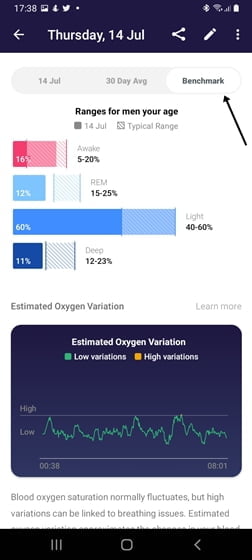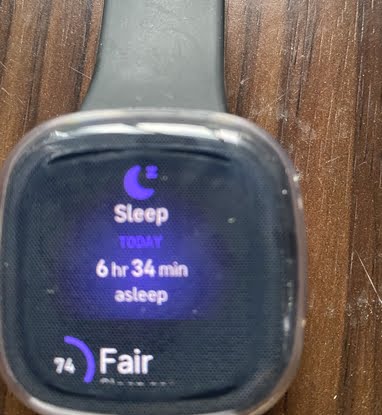Based on research, sleep plays a major role in tissue growth, memory consolidation, and rejuvenation. And the ability to track your sleep is one of the fine features of the Fitbit Versa 3. You only need to wear your Versa 3 to sleep and it will automatically track your sleep. The Versa 3 will track your sleep in four stages which include awake, light, deep, and REM sleep stages. It will also track your oxygen variations and other metrics restricted to Fitbit Premium subscribers. In this guide, you will learn how to track your sleep with Fitbit Versa 3 or Sense and we’ll also show you the sleep tracking accuracy tests results of the Versa 3.
Types of Sleep Stages and Their Benefits

There are two major stages of sleep; non-rapid eye movement (NREM) and rapid eye movement (REM). The NREM stage consists of N1, N2, and N3 stages. There is also the awake stage of sleep which is when your eyes are still open and about to sleep.
Thus, there are five stages of sleep which include, awake, N1, N2, N3, and REM sleep stages.
The N1 and N2 stages are grouped under light sleep stages, while N3 reps the deep sleep stage. Meanwhile, the Versa 3 tracks your sleep in four stages; awake, light, deep, and REM stages.
- Awake stage
- N1 stage (accounts for 5% of total sleep)
- N2 stage (accounts for 45% of total sleep)
- N3 stage (accounts for 25% of total sleep)
- REM stage (accounts for 25% of total sleep)
The first stage of sleep is the wakefulness stage, and its EEG recordings show that it’s characterized by beta and alpha waves similar to those seen in the REM sleep stage. The beta waves dominate when the eyes are still open and the alpha waves dominate when we close our eyes.
When you wear your Versa 3 to sleep, it will track the awake stage, but will only show you the actual sleep time which excludes the awake stage.
The next stage of sleep is the N1 stage which is the lightest form of sleep and occurs in short episodes of 1-5 minutes. It accounts for about 5% of total sleep, and its EEG recordings show that it’s characterized by low-amplitude mixed frequency (LAMF) waves and theta waves. It starts when more than half of the alpha waves in the wakefulness stage are replaced by LAMF waves. During the N1 stage, breathing and the heart rate slow down, and eye movements stop while the muscles relax. It’s very easy to wake anyone in the N1 stage.
The next stage of sleep is the N2 stage which is a deeper form of light sleep. The first episode of the N2 stage lasts about 25 minutes and it gets longer in subsequent cycles. The N2 stage accounts for about 45% of total sleep and the EEG recordings of this stage show it’s characterized by sleep spindles, K-complexes, or both. Studies suggest that sleep spindles and K-complexes play important roles in memory consolidation and maintaining sleep.
In this stage, breathing and heart rate slow even further with the muscles relaxed, and the body temperature also drops.
The N3 stage of NREM sleep is the deepest form of sleep often referred to as restful sleep because in this stage the body undergoes repairs, builds muscles, and strengthens the immune system. The N3 stage also called deep sleep accounts for about 25% of total sleep.
In this stage, breathing and the heart rate are at their lowest levels and the muscles become totally relaxed. Bedwetting and sleepwalking occur at this stage, and it’s hard to wake anyone in the N3 stage of sleep.
EEG recordings shows that the N3 stage is characterized by slow frequency waves called delta waves. Deep sleep is affected by age as older individuals tend to get less deep sleep and more light sleep.
Often associated with dreaming, the REM sleep stage first occurs about 90 minutes after we fall asleep, and it lasts about 10 minutes, then it gets longer in subsequent sleep cycles. EEG recordings show that REM sleep is characterized by beta and alpha waves similar to those seen in the awake stage of sleep. Although, the muscles are actually paralyzed to prevent us from acting out our dreams.
During the REM sleep stage, the breathing rate is faster and irregular, the heart rate is also increased and the eyes move rapidly from side to side behind closed eyelids. Most dreams occur during the REM sleep stage, though some may occur in the NREM stage.
REM sleep is usually the last phase leading to when we wake up which is why we tend to remember our dreams. Studies suggest REM sleep plays an important role in memory rejuvenation.
How to Track Sleep With Fitbit Versa 3
As long as you wear the Versa 3 to bed, it will automatically track your sleep. To get the best sleep result, you need to wear the Versa 3 properly. It shouldn’t be too tight or too loose, and you should give 1-2 inches of space from your wrist.
When you wear the Versa 3 to sleep, it’ll track your actual sleep time and time spent in each of the stages. When you wake up in the morning, the Versa 3 will automatically show your sleep record but not immediately as it needs some time to sync with the Fitbit app.
To immediately see your sleep result, simply open the Fitbit app and pull down as you would on a chrome browser to refresh the page, this will sync to your Versa 3, and you would be able to see your sleep record immediately.
![]()
You can easily see your sleep result from the Versa 3 by swiping up from the homescreen, then scroll to the sleep section and tap on it.

To see a more detailed result of your sleep as well as your sleep history, you need to access the Fitbit app. Open the app, scroll to the sleep section and select it.

In the Fitbit app, you can see your actual sleep time which excludes time spent awake. Further down, you get to see time spent in each stage of sleep as well as the percentage.
You also get to see your average sleep stage for the past 30 days as well as a benchmark of individuals within your age bracket.
If you scroll down further, you will see your blood oxygen variations. High variations can be a sign of breathing issues.
Other data that the Versa 3 tracks are restlessness, sleeping heart rate, and noise all of which are restricted to Fitbit Premium subscribers.
How to Track Blood Oxygen With Fitbit Versa 3

Maintaining normal blood oxygen during sleep is important for total body and memory recovery. The red blood cells carry oxygen from the lungs to every other cell in the body, and with adequate oxygen in the cells, they are able to carry out metabolic processes properly. The normal blood oxygen level is 95% and above.
The Fitbit Versa 3 will track your blood oxygen when you wear it to sleep. The blood oxygen feature doesn’t support spot check, it only tracks your blood oxygen during sleep.
To see your blood oxygen level with the Versa 3 or Sense, you’ll need to install a Spo2 watch face. Simply open the Fitbit app, go to the device’s dashboard, and select gallery. Tap on clocks, scroll down to the spo2 watch face section, select any of your choices and install it. Note that the Spo2 watch face isn’t available in every country.
While you need to only install a Spo2 watch face to view your blood oxygen level on Versa 2, Versa, Versa Lite, and the Ionic, the Fitbit Sense and Versa 3 require you to also install the Spo2 tracker app. When this app is installed, it won’t show up on the watch, it will run in the background.

To install the Spo2 app, simply go to the device’s dashboard, tap on Gallery, tap on apps, and use the search bar to search for the Spo2 app. Tap on install to download the app to the watch.
In other words, for the Fitbit Sense and Versa 3, you need the Spo2 tracker app to track your blood oxygen during sleep and you need the Spo2 watch face to view the result. If you only install the Spo2 watch face, the watch will show Spo2 not installed.
Fitbit Versa 3 Sleep Tracking Accuracy Test
To test the sleep tracking accuracy of the Fitbit Versa 3, I wore it to sleep alongside the Apple Watch Series 7, Galaxy Watch 4 Classic, and Huawei Band 4 Pro.
![]()
The results were almost the same except for slight differences. The actual sleep time on Versa 3 was almost the same as the other devices. Moreover, I know when I slept and woke up. Thus, I can actually say the Versa 3 has been very consistent and accurate in tracking my total sleep time.

However, we cannot say if the Versa 3 is accurate in tracking sleep stages. The time spent in each stage of sleep varies greatly among the different devices. An EEG test will be required to answer this question correctly.
[su_list icon=”icon: heart” icon_color=”#2A0116″ indent=”0″ class=””]
- Mapping Your Routes and Locations With Fitbit Versa 3 and Sense
- Making and Receiving Calls on Fitbit Sense & Versa 3 – All you need to know
- How to Activate Google Assistant on the Fitbit Sense and Versa 3
[/su_list]
Frequently Asked Questions
Why didn’t my Fitbit versa 3 track my sleep?
The two reasons why the Versa 3 won’t track your sleep are;
- Syncing issue with your phone.
- You didn’t wear the watch properly.
So the first step to fixing Versa 3 not tracking your sleep is to restart the watch. Simply press and hold the side button until you see the Fitbit logo, then release your fingers. The Versa 3 or Sense will restart. Then open the Fitbit app, and pull down to refresh. It will sync with your Versa 3 and you should be able to see your sleep results.
Secondly, you should wear Versa 3 properly. It shouldn’t be too tight nor should it be loose. You also need to give a 1-2 inches gap from your wrist.
How accurate is Fitbit versa 3 sleep tracking?
Based on many nights of comparison against other wearable devices, the Versa 3 has been very consistent and accurate in tracking my total sleep time.
However, we cannot authoritatively say how accurate it is in tracking sleep stages, we need an EEG test to give that answer.
Why won’t my Fitbit give me a sleep score?
If you wake up from sleep and you don’t see a sleep score in the Fitbit app, it’s obviously a syncing issue with the Versa 3 or you didn’t get enough sleep.
To fix this, you need to first restart the Versa 3 or Sense by pressing and holding the side haptic button until the Fitbit logo appears. Then release your finger and the Versa 3 will restart.
Secondly, make sure your Fitbit app is up to date. Locate the Fitbit app In the Google Playstore or Apple app store and ensure it’s up to date.
If you have restarted the Versa 3 and the Fitbit app is updated, open the app and pull to refresh. It will sync the Versa 3 and you should be able to now see your sleep score.
Does Fitbit automatically track sleep?
Yes, the Versa 3 will automatically track your sleep when you wear it to bed. It automatically detects you are sleeping based on your body movements. Thus, it can also track your naps.
How much deep sleep is normal?
Sleep researchers say the deep sleep stage accounts for 25% of total sleep and a typical night’s sleep last 7-8hrs for adults.
In this regard, adults should aim to get 25% of 7-8hrs of sleep. This represents 1hr 45mins to 2hrs of deep sleep. Teenagers get about 9.5hrs of sleep on average and should aim to get 2hrs 22minutes of deep sleep.
Babies get 16-18hrs of sleep and most of this time is spent in deep sleep. Note that deep and REM sleep decreases for the elderly once as they spend more time in light sleep.
How much REM sleep is normal?
Just like deep sleep, REM sleep accounts for 25% of total sleep. So as an adult, you should aim to get 1hrs 45minutes to 2hrs of REM sleep.
Conclusions
Bottom line, the Fitbit Sense or Versa 3 will track your sleep in four stages. It can also track your blood oxygen during sleep and will give you a sleep score. From my tests and comparisons with other high-end smartwatches, the Versa 3 is consistent and accurate in tracking my total sleep time.

